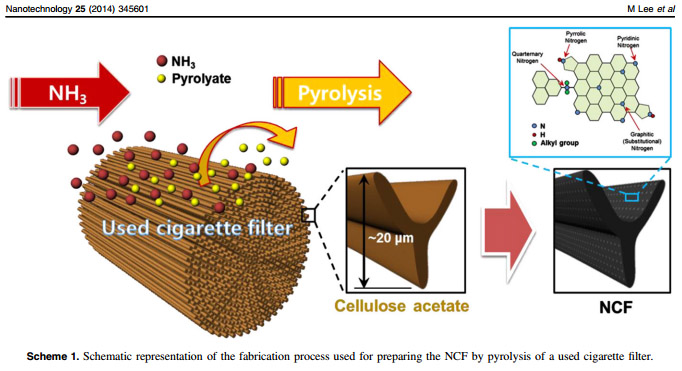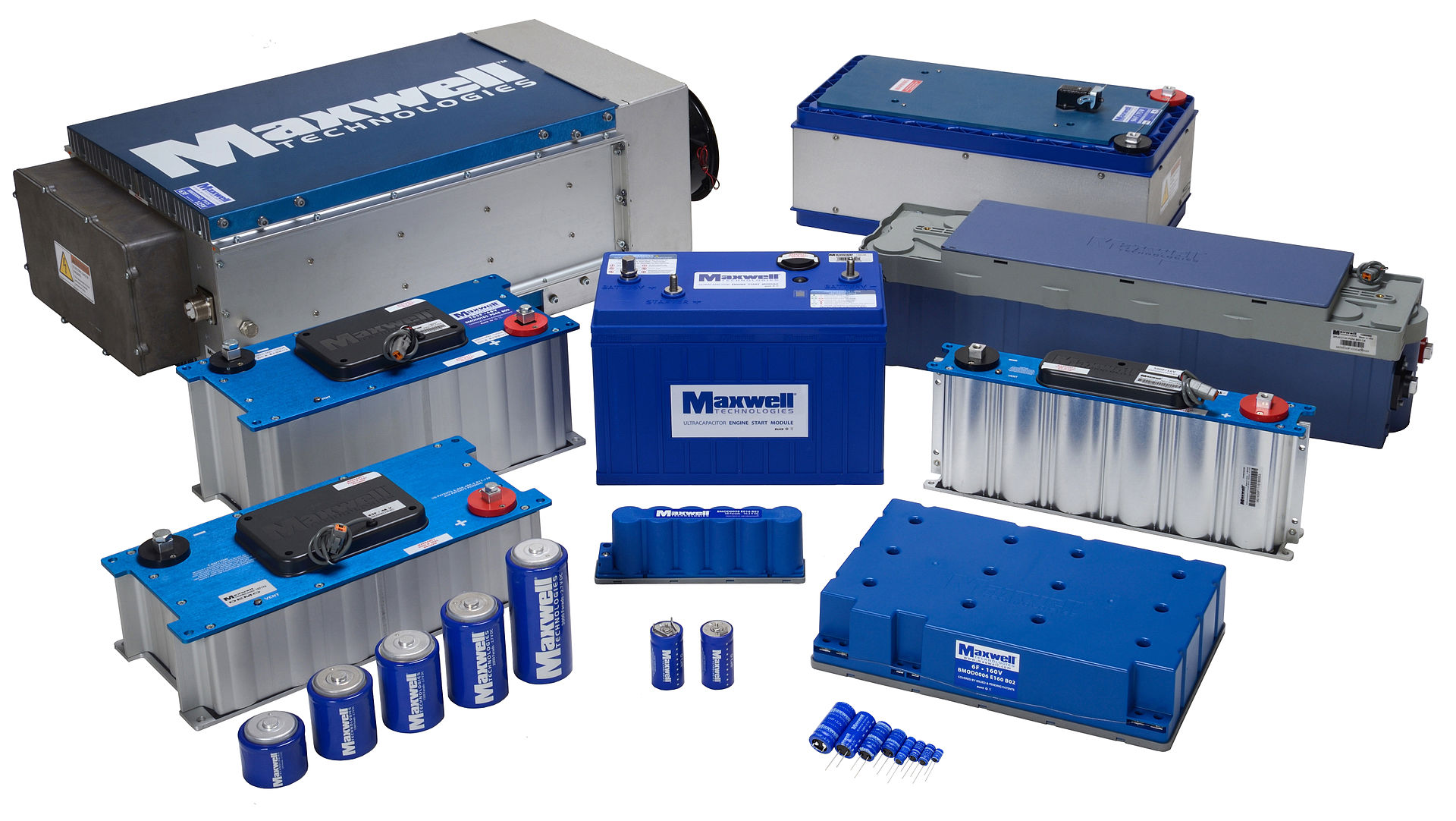It looks like you're using an Ad Blocker.
Please white-list or disable AboveTopSecret.com in your ad-blocking tool.
Thank you.
Some features of ATS will be disabled while you continue to use an ad-blocker.
13
share:
Into the electrode portion anyway.
 image source and
click for larger image
image source and
click for larger image
Pop Sci: Scientists Turn Cigarette Butts Into Electrical Storage
Link to paper in Nanotechnology
That's some serious materials science hacking.
I'm not sure how this stacks up in terms of cost to other materials being used in current supercapacitors but they're claiming it stores more energy and clearly the machines to mass produce cheap cigarette filters exist so maybe this is a material we'll see utilized by supercapacitor manufacturers in the near future.
For those who aren't familiar with supercapacitor/ultracapacitors, they've been on the verge of replacing rechargeable batteries for it seems like forever but so far they've only managed to find their way into niche applications such as Mazda's regenerative braking system. One of the biggest reasons for their lack of adoption has been that while supercapacitors charge in a fraction of the time of batteries and have lifetimes of many many more charge cycles, their energy densities are conversely poor with even the recent supercapacitor technologies storing less than half the energy of similarly sized conventional batteries.
..and here's a picture of some Maxwell Technologies supercapacitor products from Wikipedia because they look cool


Pop Sci: Scientists Turn Cigarette Butts Into Electrical Storage
The electrical power of the future just might be waiting in ashtrays across the world. Researchers in South Korea discovered that, with a one-step conversion process, cigarette filters turn into great supercapacitors.
Used cigarette filters are composed largely of cellulose acetate. They are disposable, non-biodegradable, toxic and are a threat to the environment after usage. However, it has been reported that cellulose acetate can be directly utilized in the production of carbon materials containing a meso-/micropore structure by only a carbonization process [14].
In essence, the scientists burned the filters in a nitrogen-rich environment, and this made the filter fibers grow pores, further increasing their surface area. According to their results, published in the journal Nanotechnology, these burnt-in-nitrogen fibers stored more energy than materials previously used in supercapacitors.
Link to paper in Nanotechnology
That's some serious materials science hacking.
I'm not sure how this stacks up in terms of cost to other materials being used in current supercapacitors but they're claiming it stores more energy and clearly the machines to mass produce cheap cigarette filters exist so maybe this is a material we'll see utilized by supercapacitor manufacturers in the near future.
For those who aren't familiar with supercapacitor/ultracapacitors, they've been on the verge of replacing rechargeable batteries for it seems like forever but so far they've only managed to find their way into niche applications such as Mazda's regenerative braking system. One of the biggest reasons for their lack of adoption has been that while supercapacitors charge in a fraction of the time of batteries and have lifetimes of many many more charge cycles, their energy densities are conversely poor with even the recent supercapacitor technologies storing less than half the energy of similarly sized conventional batteries.
..and here's a picture of some Maxwell Technologies supercapacitor products from Wikipedia because they look cool

edit on 2014-8-8 by theantediluvian because: (no reason given)
a reply to: theantediluvian
I find it a little hard to believe that a cigarette filter would beat a 50nm Barium Titanate thin film semiconductor substrate rolled into the same size. But hey, if it's 99% cheaper and half as efficient then we're good to go I guess!
Cheers - Dave
I find it a little hard to believe that a cigarette filter would beat a 50nm Barium Titanate thin film semiconductor substrate rolled into the same size. But hey, if it's 99% cheaper and half as efficient then we're good to go I guess!
Cheers - Dave
originally posted by: bobs_uruncle
a reply to: theantediluvian
I find it a little hard to believe that a cigarette filter would beat a 50nm Barium Titanate thin film semiconductor substrate rolled into the same size. But hey, if it's 99% cheaper and half as efficient then we're good to go I guess!
for automotive applications, lighter works too.
originally posted by: mbkennel
originally posted by: bobs_uruncle
a reply to: theantediluvian
I find it a little hard to believe that a cigarette filter would beat a 50nm Barium Titanate thin film semiconductor substrate rolled into the same size. But hey, if it's 99% cheaper and half as efficient then we're good to go I guess!
for automotive applications, lighter works too.
Energy density is scalable and based largely on the effective area for super-capacitors as well as the substrate material's ability to retain charge over time. Of course the +/- electrodes also have to have the ability to charge or release energy at reasonable rates without resistive heating. All these parts have weight based on volume. Whether Barium Titanate or cellulose is used as a substrate, the end weight based on equivalent energy density will be close to the same (probably +/- 5%)
Little experiment to try if you are into H2O2 production (HHO).... Get a pair of copper electrodes, say 12 sq inches at a spacing of about 1/10" inch. Power than up in a solution of weak sodium hydroxide and distilled water and measure your H2 output flow. Then use identical plates that are acid etched to produce 2x to 3x the surface area and measure again. Then use a pair of exactly the same electrodes and sputter them with carbon so that you have 1000x to 5000x times the effective area, measure the flow again. Area determines output.
Cheers - Dave
new topics
-
Stalker 2 - Review from a Veteran
Video Games: 2 hours ago -
Does anyone have a link to download apple pay for androids
General Chit Chat: 2 hours ago -
Most INSANE internet rabbit hole
Secret Societies: 3 hours ago -
Joe Rogan conspiracy (maybe)
ATS Skunk Works: 7 hours ago -
Results of the use of the Oreshnik missile system in Dnepropetrovsk
World War Three: 9 hours ago -
Nigel Farage now the Most Favoured UK Politician
Regional Politics: 10 hours ago
top topics
-
Little Johnny and Larry should team up
General Chit Chat: 17 hours ago, 13 flags -
Results of the use of the Oreshnik missile system in Dnepropetrovsk
World War Three: 9 hours ago, 12 flags -
Most INSANE internet rabbit hole
Secret Societies: 3 hours ago, 8 flags -
Nigel Farage now the Most Favoured UK Politician
Regional Politics: 10 hours ago, 4 flags -
Joe Rogan conspiracy (maybe)
ATS Skunk Works: 7 hours ago, 4 flags -
Will Us use alien technology to fight in ww3?
World War Three: 17 hours ago, 3 flags -
Stalker 2 - Review from a Veteran
Video Games: 2 hours ago, 2 flags -
Does anyone have a link to download apple pay for androids
General Chit Chat: 2 hours ago, 1 flags
active topics
-
Elon Says It’s ‘Likely’ He Buys Tanking MSNBC
Political Ideology • 76 • : Astrocometus -
Joe Rogan conspiracy (maybe)
ATS Skunk Works • 3 • : Shoshanna -
Does anyone have a link to download apple pay for androids
General Chit Chat • 7 • : lilzazz -
-@TH3WH17ERABB17- -Q- ---TIME TO SHOW THE WORLD--- -Part- --44--
Dissecting Disinformation • 3360 • : Thoughtful3 -
Results of the use of the Oreshnik missile system in Dnepropetrovsk
World War Three • 160 • : RickyD -
Montelukast affects brain, caused 5 year old to attempt suicide
Medical Issues & Conspiracies • 12 • : lilzazz -
Jaguar Rebrand Video Causes "WTF?" Moment - Seriously Weird
Automotive Discussion • 27 • : lilzazz -
Stalker 2 - Review from a Veteran
Video Games • 2 • : CriticalStinker -
President-Elect DONALD TRUMP's 2nd-Term Administration Takes Shape.
Political Ideology • 241 • : WeMustCare -
Will Us use alien technology to fight in ww3?
World War Three • 14 • : DaydreamerX
13
